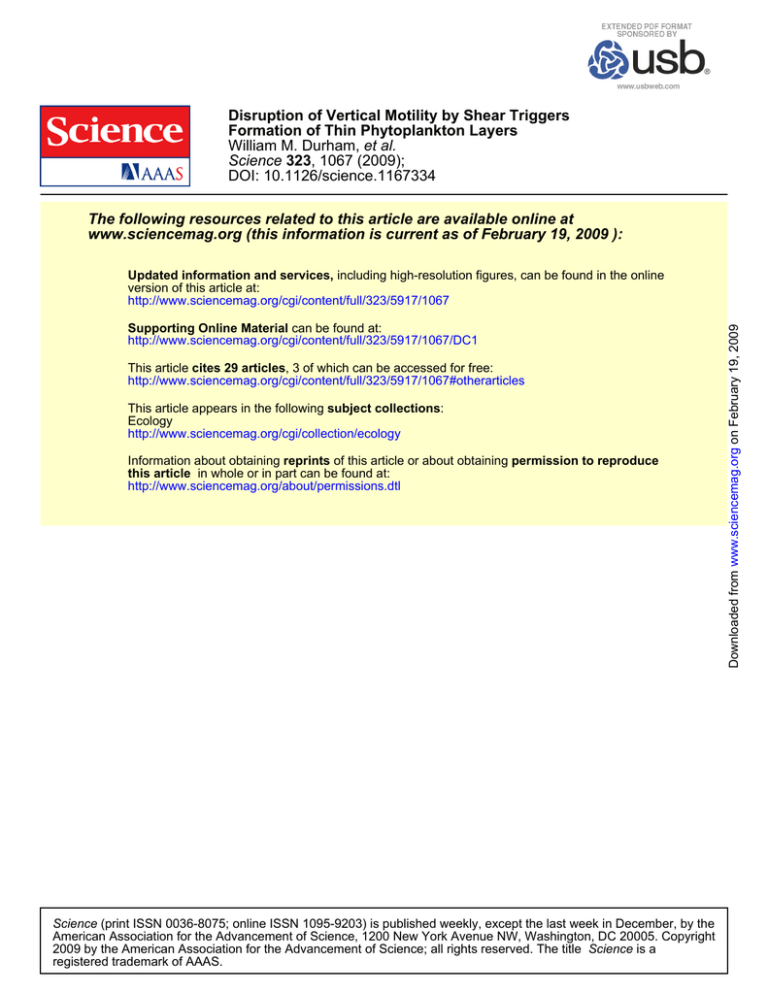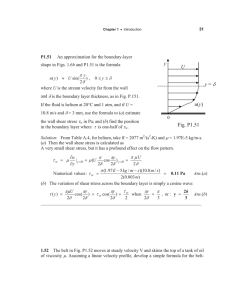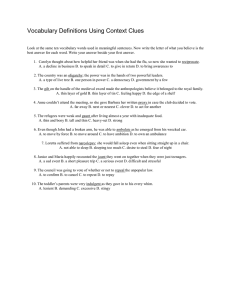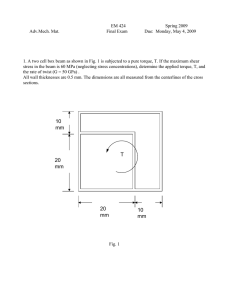
Disruption of Vertical Motility by Shear Triggers
Formation of Thin Phytoplankton Layers
William M. Durham, et al.
Science 323, 1067 (2009);
DOI: 10.1126/science.1167334
The following resources related to this article are available online at
www.sciencemag.org (this information is current as of February 19, 2009 ):
Supporting Online Material can be found at:
http://www.sciencemag.org/cgi/content/full/323/5917/1067/DC1
This article cites 29 articles, 3 of which can be accessed for free:
http://www.sciencemag.org/cgi/content/full/323/5917/1067#otherarticles
This article appears in the following subject collections:
Ecology
http://www.sciencemag.org/cgi/collection/ecology
Information about obtaining reprints of this article or about obtaining permission to reproduce
this article in whole or in part can be found at:
http://www.sciencemag.org/about/permissions.dtl
Science (print ISSN 0036-8075; online ISSN 1095-9203) is published weekly, except the last week in December, by the
American Association for the Advancement of Science, 1200 New York Avenue NW, Washington, DC 20005. Copyright
2009 by the American Association for the Advancement of Science; all rights reserved. The title Science is a
registered trademark of AAAS.
Downloaded from www.sciencemag.org on February 19, 2009
Updated information and services, including high-resolution figures, can be found in the online
version of this article at:
http://www.sciencemag.org/cgi/content/full/323/5917/1067
Disruption of Vertical Motility by
Shear Triggers Formation of Thin
Phytoplankton Layers
William M. Durham,1 John O. Kessler,2 Roman Stocker1*
Thin layers of phytoplankton are important hotspots of ecological activity that are found in the
coastal ocean, meters beneath the surface, and contain cell concentrations up to two orders of
magnitude above ambient concentrations. Current interpretations of their formation favor abiotic
processes, yet many phytoplankton species found in these layers are motile. We demonstrated
that layers formed when the vertical migration of phytoplankton was disrupted by hydrodynamic
shear. This mechanism, which we call gyrotactic trapping, can be responsible for the thin layers of
phytoplankton commonly observed in the ocean. These results reveal that the coupling between
active microorganism motility and ambient fluid motion can shape the macroscopic features of the
marine ecological landscape.
dvances in underwater sensing technology over the past three decades have revealed the occurrence throughout the
oceans of intense assemblages of unicellular
photosynthetic organisms known as thin layers.
Thin layers are centimeters to meters thick (1)
and extend horizontally for kilometers (2). They
often occur in coastal waters (1–4), in regions of
vertical gradients in density where they are partially sheltered from turbulent mixing (1), and
can persist for hours to days (2, 5–7). Thin phytoplankton layers contain elevated amounts of
A
marine snow and bacteria (6, 8), enhance zooplankton growth rates (7), and provide the prey
concentrations essential for the survival of some
fish larvae (9). On the other hand, because many
phytoplankton species found in these layers are
toxic (2, 3, 5, 10, 11), thin layers can disrupt
grazing, enhance zooplankton and fish mortality,
and seed harmful algal blooms at the ocean
surface (2, 5, 10). The large biomass found in thin
layers can influence optical and acoustic signatures in the ocean (1, 6, 8). Understanding the
mechanisms driving thin layer formation is
critical for predicting their occurrence and ecological ramifications.
Phytoplankton species found in thin layers
are often motile (2, 3, 5, 9, 11). The interplay
between motility and fluid flow can result in
complex and ecologically important phenomena,
including localized cell accumulations (12, 13)
and directed swimming against the flow in
zooplankton (13), bacteria (14), and sperm (15).
Phytoplankton motility, coupled with shear, can
lead to a striking focusing effect known as gyrotaxis (12). Shear, in the form of vertical gradients
in horizontal fluid velocity, can be generated by
tidal currents (1), wind stress (1), and internal
waves (16) and is often enhanced within thin
layers (4, 17). Here, we propose a mechanism for
thin layer formation in which a population of
motile phytoplankton accumulates where shear
exceeds a critical threshold: We have called this
phenomenon gyrotactic trapping.
Many phytoplankton species exhibit gravitaxis, a tendency to swim upward against gravity.
Gravitaxis can result from a torque caused by
asymmetry in shape (18) or in distribution of
body density (12) or through active sensing (19).
Hydrodynamic shear imposes a viscous torque
1
Department of Civil and Environmental Engineering,
Massachusetts Institute of Technology (MIT), Cambridge,
MA 02139, USA. 2Department of Physics, University of
Arizona, Tucson, AZ 85721, USA.
*To whom correspondence should be addressed. E-mail:
romans@mit.edu
Fig. 1. Gyrotactic trapping. (A) A gyrotactic
phytoplankton’s center
of mass (red) is displaced from its center
of buoyancy (x = z = 0).
As a result, the swimming direction q in a
shear flow, u(z), is set by
the balance of gravitational (Tg) and viscous
(Tv) torques. V is swimming speed and m is
mass. (B) Schematic of
gyrotactic trapping. Cells
can migrate vertically at
low shear but tumble
and become trapped
where |S| > SCR, accumulating in a thin layer. (C)
Experimental apparatus
to test gyrotactic trapping. The rotating belt
generated a depthvarying shear S(z) in
the underlying flow
chamber.
www.sciencemag.org
SCIENCE
VOL 323
20 FEBRUARY 2009
Downloaded from www.sciencemag.org on February 19, 2009
REPORTS
1067
REPORTS
on cells. The swimming direction, q, is then set
by the balance of viscous and gravitactic torques
(Fig. 1A), and cells are said to be gyrotactic (12).
Consider a spherical cell of radius a and mean
density r (Fig. 1A), with an asymmetric density
distribution creating an offset, L, between its
center of mass and its center of buoyancy (an
equivalent L can be used to characterize gravitaxis resulting from shape or sensing). When
exposed to shear S, the cell swims upward in the
direction sinq = BS (12), where B = 3m/rLg is the
gyrotactic reorientation time scale, m the dynamic
fluid viscosity, and g the acceleration of gravity.
This results from the vorticity component of
shear, whereas elongated cells would further be
affected by the rate of strain component.
We show that vertical gradients (S = ∂u/∂z) in
horizontal velocity u can disrupt vertical migration of gyrotactic phytoplankton, causing them to
accumulate in layers. When |S| > SCR = B−1, the
stabilizing gravitational torque that acts to orient
cells upward is overwhelmed by the hydrodynamic torque that induces them to spin: Upward
migration is disrupted, because no equilibrium
orientation exists (|sinq| must be ≤1), and cells
tumble end over end, accumulating where they
tumble (Fig. 1B). We demonstrated that gyrotactic trapping triggers layer formation by exposing
the green alga Chlamydomonas nivalis and the
toxic raphidophyte Heterosigma akashiwo (Fig.
1068
Downloaded from www.sciencemag.org on February 19, 2009
Fig. 2. Thin phytoplankton layers. (A) Multipleexposure image showing a thin layer of C. nivalis
(t = 12 min, x = 21.5 cm). Cells in high shear (z >
0.5 cm) were trapped, whereas those beneath
(|S| < SCR) swam upward, forming a thin layer. (B)
Corresponding profile of measured flow velocities
u (black dots), along with a quadratic fit (red) and
the associated shear S = ∂u/∂z (blue). Because u(z)
was parabolic, S increased linearly with z. (Inset)
C. nivalis, showing the two flagella used for
swimming. Scale bar indicates 10 mm. (C) Thin
layer of H. akashiwo. (D) Same as (B), for experiments in Fig. 2C. (Inset) H. akashiwo, showing one
flagellum (a second resides in a ventral groove).
Scale bar, 10 mm.
Fig. 3. Formation of a thin layer. (A) Cell concentration profiles C(z) observed experimentally (solid lines) and
numerically (dashed line), normalized by Cmax observed at t = 12 min, x = 21.5 cm. (B) Upward swimming
speed, w, at t = 2 min (red line) and standard deviation across four observations (blue strip and inset). W is the
depth-averaged value of w. The dashed line shows the numerical simulation. The peak in w(z) at S ≈ 0 (gray
line) and the deterioration in w(z) for |S| > 0 are consistent with gyrotaxis and were responsible for layer
formation. (Inset) W decreased with time, as the proportion of cells reaching their critical shear rate increased.
2, B and D, insets) to a linearly varying shear,
S(z) (Fig. 2, B and D), in a 1-cm-deep chamber (Fig. 1C). C. nivalis is a classic model for
gyrotaxis (12), whereas H. akashiwo has been the
20 FEBRUARY 2009
VOL 323
SCIENCE
culprit of numerous large-scale fish kills and is
known to form thin layers (11).
In our experiments, C. nivalis consistently
formed intense thin layers (Fig. 2A). The dynamics
www.sciencemag.org
Fig. 4. Cell accumulation and trajectories. (A) Thin layer obtained from
the numerical model at t = 12 min for conditions that simulated
experiments with C. nivalis (Fig. 3A). Color denotes normalized cell
concentration (the high concentrations at the lower right represent the
region of injection). (B) Transition between two swimming regimes,
demonstrated by experimental (solid) and numerical (dashed) trajectories.
Where |S| < SCR (white background), cells migrated upward, whereas |S| >
SCR (gray background) triggered tumbling and trapping. Shading represents the mean critical shear rate SCR = 0.2 s−1, although a statistical
variability existed among cells. Dots mark beginning of trajectories.
Fig. 5. Thin layer formation by gyrotactic trapping
in the ocean. (A) A flow velocity profile (red line)
typical of regions where thin layers are observed
(1, 4) was used in a continuum model to predict
the effect of gyrotactic trapping in the ocean.
Enhanced shear S = ∂u/∂z (blue line) triggers a
reduction in upward swimming speed w (green
line). (B) The model shows that an initially uniform population (cyan line) develops a localized
accumulation within 3 hours (pink line) and forms an intense thin layer within 12 hours (orange
line). Turbulence was parameterized by a vertical eddy diffusivity D = 10−5 m2 s−1.
of thin layer formation were captured by using
video microscopy (Fig. 3A). Initially (time t =
6 min, horizontal position x = 11.5 cm), cells
entered the field of view with a broad distribution. Subsequently (t = 8.5 min, x = 16.5 cm), a
4-mm-wide thin layer formed as a result of the
uppermost cells becoming trapped where SCR ≈
0.2 s−1 and the cells beneath them still swimming
upward. The location of cell accumulation
corresponded to a gyrotactic reorientation time
B = 1/SCR ≈ 5 s, in good agreement with previous
literature values [B ≈ 1 to 6 s (20, 21, 22)]. The
thin layer grew more intense over time, peaking
at t = 12 min. Importantly, motility was critical
for layer formation: No layers were observed to
form when we used dead cells. H. akashiwo also
produced thin layers, which were so intense that
they were visible to the naked eye (Fig. 2C), at a
depth corresponding to SCR ≈ 0.5 s−1.
Was gyrotaxis the mechanism underlying
layer formation? According to theory, the mean
upward speed, w, of a population of gyrotactic
www.sciencemag.org
SCIENCE
VOL 323
cells decreases with increasing shear. Measured
vertical profiles of w(z) from 70,000 C. nivalis
trajectories (Fig. 3B) strongly support the occurrence of gyrotactic trapping: w(z) peaked at S = 0
and decreased above and below. These observations were corroborated by numerical simulations of 50,000 cell trajectories under conditions
mimicking the experiments (23) (movie S1). The
simulations resulted in the formation of an intense thin layer (Fig. 4A), with cell concentration
C(z) closely matching observations (Fig. 3A).
Furthermore, w(z) decayed with increasing S, as
in experiments (Fig. 3B).
Gyrotactic trapping requires a transition in
swimming kinematics when |S| = SCR for a thin
layer to form. To verify the existence of this
transition, we tracked individual C. nivalis cells.
Trajectories clearly revealed two distinct regimes
(Fig. 4B and movie S2): for |S| < SCR, cells swam
upward, whereas for |S| > SCR they tumbled.
Numerical and experimental trajectories exhibited clear similarities in the amplitude and frequency of tumbles, the rate of upward swimming
for |S| < SCR, and the presence of cells temporarily expelled from the lower side of the layer
only to swim back upward moments later.
Can gyrotactic trapping contribute to layer
formation in the ocean, where vertical distances
are of the order of meters and turbulence may
destroy vertical heterogeneity? To find out, we
developed a continuum model of cell concentration, C, in the upper 10 m of the ocean, starting
with a uniform distribution and accounting for
turbulence intensities typical of thin layers (24)
via a uniform eddy diffusivity, D = 10−5 m2 s−1.
Even for a conservatively low maximum upward
swimming speed wmax = 100 mm s−1 (11, 25),
phytoplankton began to accumulate just beneath
the depth of maximum shear within three hours,
and the intensity of the layer strengthened over
12 hours (Fig. 5B). These time scales are consistent with field observations (7). Turbulence
20 FEBRUARY 2009
Downloaded from www.sciencemag.org on February 19, 2009
REPORTS
1069
subsequently eroded the layer, reducing peak
concentration by 50% after 30 hours. Consideration of a local reduction in eddy diffusivity,
typically encountered at the pycnocline, further
increases layer intensity and duration. Importantly, we predict layer formation for shear rates
(S = 0.12 s−1) comparable to those observed in
thin layers (up to S = 0.088 s−1) (1, 4), particularly considering that the latter likely underestimate peaks in shear because of coarse
(meter-scale) sampling (1, 4). Furthermore, recent high-resolution measurements find S in excess of 0.5 s−1 in coastal waters (26), although the
temporal coherence of these events remains to be
determined.
Given the wide range of environmental conditions and species associated with thin layers, it
is unlikely that a single mechanism is responsible
for all layers (27). Although several mechanisms
have been hypothesized, including in situ growth
(24), buoyancy (27), and motility toward optimal
resource levels (5), straining of a phytoplankton patch by shear is currently the most invoked
(4, 16, 24, 27). Our findings offer an alternative
explanation of the role of shear: Regions of enhanced shear disrupt vertical motility and trigger
sharp-peaked cell accumulations ex novo (Fig.
5B). This could occur routinely in natural water
bodies because many species of phytoplankton
are gyrotactic (28). Contrary to straining, gyrotactic trapping predicts that a mixture of phytoplankton species with differing gyrotactic behavior
(e.g., B) will be sorted into multiple monospecific
layers at different depths: Such vertical species
separation is often observed in the ocean (29) and
can affect zooplankton foraging and the spread of
viral epidemics.
Gyrotactic trapping suggests that stabilization
against tumbling might represent an evolutionarily selected trait for vertically migrating phytoplankton species. The parameter B−1 measures a
cell’s stability against overturning by shear.
Whereas no stabilization (B−1 = 0) leaves the cell
at the mercy of flow even at very small shear
rates, stabilization is limited by biomechanical
constraints (e.g., how bottom-heavy a cell can
be) and excessive stabilization hinders maneuverability in exploiting nutrient patches and
escaping predators. Although a simple model
suggests that biomechanical constraints are not
the only determinants of cell stability (23), further investigation is needed to establish the
importance of stabilization in determining cell
morphology.
The importance of motility in governing the
spatial distribution of microorganisms in the ocean
has been emphasized in recent years, chiefly for
bacteria navigating patchy distributions of organic
matter (30, 31). Here we have demonstrated that
motility and shear can generate intense thin layer
accumulations of phytoplankton by gyrotactic
trapping. By focusing resources, thin layers shape
ecological interactions and can significantly affect
trophic transfer and biogeochemical fluxes (7).
Our results reveal how prominent macroscopic
1070
features of the marine landscape can originate
from the microscopic coupling between flow and
the motility of some of its smallest inhabitants.
References and Notes
1. M. M. Dekshenieks et al., Mar. Ecol. Prog. Ser. 223, 61
(2001).
2. T. G. Nielsen, T. Kiørboe, P. K. Bjørnsen, Mar. Ecol. Prog.
Ser. 62, 21 (1990).
3. D. W. Townsend, N. R. Pettigrew, A. C. Thomas,
Deep-Sea Res. Part II Top. Stud. Oceanogr. 52, 2603
(2005).
4. J. P. Ryan, M. A. McManus, J. D. Paduan, F. P. Chavez,
Mar. Ecol. Prog. Ser. 354, 21 (2008).
5. P. K. Bjørnsen, T. G. Nielsen, Mar. Ecol. Prog. Ser. 73,
263 (1991).
6. M. A. McManus et al., Mar. Ecol. Prog. Ser. 261, 1 (2003).
7. T. J. Cowles, R. A. Desiderio, M. Carr, Oceanography 11,
4 (1998).
8. A. L. Alldredge et al., Mar. Ecol. Prog. Ser. 233,
1 (2002).
9. R. Lasker, Fish. Bull. (Washington) 73, 453 (1975).
10. P. L. Donaghay, T. R. Osborn, Limnol. Oceanogr. 42,
1283 (1997).
11. S. Yamochi, T. Abe, Mar. Biol. (Berl.) 83, 255 (1984).
12. J. O. Kessler, Nature 313, 218 (1985).
13. A. Genin, J. S. Jaffe, R. Reef, C. Richter, P. J. S. Franks,
Science 308, 860 (2005).
14. J. Hill, O. Kalkanci, J. L. McMurray, H. Koser, Phys. Rev.
Lett. 98, 068101 (2007).
15. F. P. Bretherton, L. Rothchild, Proc. R. Soc. London Ser. B
153, 490 (1961).
16. P. J. S. Franks, Deep-Sea Res. Part I Oceanogr. Res. Pap.
42, 75 (1995).
17. T. J. Cowles, in Handbook of Scaling Methods in Aquatic
Ecology: Measurements, Analysis, Simulation, L. Seuront,
P. G. Strutton, Eds. (CRC, Boca Raton, FL, 2003),
pp. 31–49.
18. A. M. Roberts, F. M. Deacon, J. Fluid Mech. 452, 405
(2002).
19. M. Lebert, D. P. Häder, Nature 379, 590 (1996).
20. M. S. Jones, L. Le Baron, T. J. Pedley, J. Fluid Mech. 281,
137 (1994).
21. N. A. Hill, D. P. Häder, J. Theor. Biol. 186, 503 (1997).
22. T. J. Pedley, N. A. Hill, J. O. Kessler, J. Fluid Mech. 195,
223 (1988).
23. Materials and methods are available as supporting
material on Science Online.
24. D. A. Birch, W. R. Young, P. J. S. Franks, Deep-Sea Res.
Part I Oceanogr. Res. Pap. 55, 277 (2008).
25. D. Kamykowski, R. E. Reed, G. J. Kirkpatrick, Mar. Biol.
(Berlin) 113, 319 (1992).
26. J. G. Mitchell, H. Yamazaki, L. Seuront, F. Wolk, H. Li,
J. Mar. Syst. 69, 247 (2008).
27. M. T. Stacey, M. A. McManus, J. V. Steinbuck, Limnol.
Oceanogr. 52, 1523 (2007).
28. J. O. Kessler, Prog. Phycol. Res. 4, 257 (1986).
29. L. T. Mouritsen, K. Richardson, J. Plankton Res. 25, 783
(2003).
30. R. Stocker, J. R. Seymour, A. Samadani, D. E. Hunt,
M. F. Polz, Proc. Natl. Acad. Sci. U.S.A. 105, 4209
(2008).
31. F. Azam, F. Malfatti, Nat. Rev. Microbiol. 5, 782 (2007).
32. We thank P. Franks, W. Young, D. Grünbaum, T. Cowles,
R. Bearon, M. Bees, D. Häder, D. Anderson, M. McManus,
and L. Karp-Boss for helpful discussions; T. Peacock for
the loan of experimental equipment; T. Clay and
S. Stransky for developing BacTrack; R. A. Cattolico for
providing H. akashiwo; and J. Mitchell, E. DeLong,
S. Chisholm, M. Polz, H. Nepf, J. Seymour, J. Bragg,
B. Kirkup, P. Reis, D. Birch, and S. Sunghwan for
comments on the manuscript. W.M.D. acknowledges a
National Defense Science and Engineering Graduate
Fellowship. J.O.K. acknowledges support from
Department of Energy grant W31-109-ENG38. R.S.
acknowledges support from NSF (OCE 0526241 and OCE
CAREER 0744641), MIT’s Earth Systems Initiative, and a
Doherty Professorship.
Supporting Online Material
www.sciencemag.org/cgi/content/full/323/5917/1067/DC1
Materials and Methods
References
Movies S1 and S2
17 October 2008; accepted 7 January 2009
10.1126/science.1167334
Cytosolic Viral Sensor RIG-I Is a
5′-Triphosphate–Dependent Translocase
on Double-Stranded RNA
Sua Myong,1*† Sheng Cui,2* Peter V. Cornish,3,4 Axel Kirchhofer,2 Michaela U. Gack,5,6,7
Jae U. Jung,5,6 Karl-Peter Hopfner,2† Taekjip Ha1,3,4†
Retinoic acid inducible–gene I (RIG-I) is a cytosolic multidomain protein that detects viral RNA and
elicits an antiviral immune response. Two N-terminal caspase activation and recruitment domains
(CARDs) transmit the signal, and the regulatory domain prevents signaling in the absence of viral
RNA. 5′-triphosphate and double-stranded RNA (dsRNA) are two molecular patterns that enable
RIG-I to discriminate pathogenic from self-RNA. However, the function of the DExH box helicase
domain that is also required for activity is less clear. Using single-molecule protein-induced
fluorescence enhancement, we discovered a robust adenosine 5´-triphosphate–powered dsRNA
translocation activity of RIG-I. The CARDs dramatically suppress translocation in the absence of
5′-triphosphate, and the activation by 5′-triphosphate triggers RIG-I to translocate preferentially on
dsRNA in cis. This functional integration of two RNA molecular patterns may provide a means to
specifically sense and counteract replicating viruses.
etinoic acid inducible–gene I (RIG-I) is a
cytosolic pattern-recognition receptor that
senses pathogen-associated molecular
patterns (PAMPs) on viral RNA and triggers an
antiviral immune response by activating type-I
R
20 FEBRUARY 2009
VOL 323
SCIENCE
interferons (IFN-a and -b) (1). A 5′-triphosphate
moiety on viral RNA is a major PAMP detected
by RIG-I as a viral signature (2, 3). 5′-triphosphates
arise during viral replication and are absent in
most cytosolic RNA because of cleavage or capping
www.sciencemag.org
Downloaded from www.sciencemag.org on February 19, 2009
REPORTS



